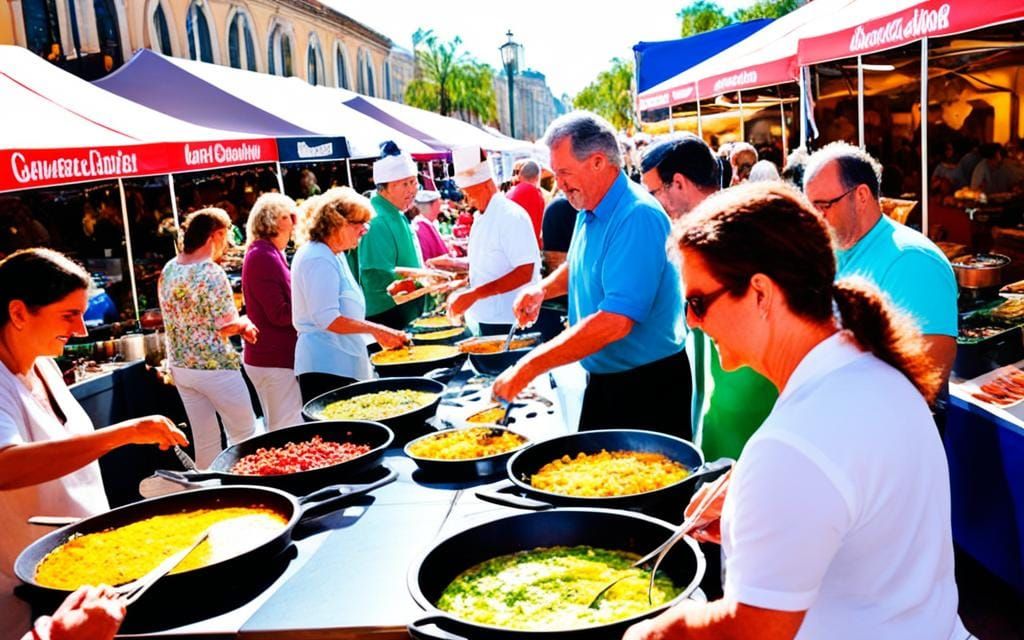Different Foods for Different Cultures – Our culinary journey shows the wide range of cultural cuisine in the world. Food brings people together and crosses borders. It lets us peek into the rich tapestry of cultures worldwide.
So, let’s start our journey and learn about seven unique dishes from different countries. We’ll explore their cultural significance, history, and traditional preparation methods.
Just seeing a pretty dish can spark excitement for the flavors that await us. This excitement goes beyond mere sustenance or taste. It dives into a place’s history, people, traditions, and even its geography.
Let’s look at these regional specialties to understand the world’s diverse dietary preferences. We’ll get to know the culinary heritage that crafts the international flavors we love.
Table of Contents
ToggleExploring the Diverse Tapestry of Global Cuisines
Asia is the largest continent with a rich food culture. Each country’s cuisine tells a story. It reflects their history, culture, and the land’s offerings. Mediterranean food shares common items like olive oil and grains. Latin American dishes mix indigenous and foreign flavors, offering a unique taste experience.
Food as a Bridge Between Cultures
Food brings people together in a powerful way. It’s a shared joy that knows no language or cultural divide. By sampling dishes from around the world, we not only enjoy new tastes but also deepen our insight into varying cultures.
The Power of Food in Storytelling and Cultural Exchange
Food acts as a guide to cultural tales and traditions. Each meal carries a piece of history, connecting us to its origins. Tasting global cuisine is more than a delight; it’s an opportunity for a cultural meeting. It helps us understand and appreciate the stories behind each dish.
The Rich Flavors of Asian Cuisine
Asian cuisine offers a wide range of tastes. From Japan’s sushi, known for its fresh seafood, to India’s spicy curries, steeped in health traditions, each dish tells a story. It shows how flavors can be both exciting and good for you.
Japan’s Sushi: Elegance and Simplicity
In Japan, sushi is more than a meal; it’s an art. The chefs there focus on the pure taste of fresh seafood. Every piece of sushi reflects the sea’s generosity and the chef’s dedication.
India’s Spice-Rich Curries: A Reflection of Ayurvedic Principles
India’s curries are filled with lively spices. They’re not just tasty; they follow ancient health guidelines. A mix of spices in each curry dish helps balance your body and mind.
Thailand’s Balanced Flavors: Sweet, Sour, Spicy, and Savory
Thailand’s food includes all main taste senses in every meal. Their dishes are a blend of hot, sour, sweet, salty, and savory. This mix isn’t just delicious; it echoes the importance of balance and moderation in life, rooted in their culture.
The Freshness of Mediterranean Cuisine
Mediterranean cuisine is known for using olive oil and lots of fresh food. It includes fresh fruits, nuts, beans, fish, and whole grains. This type of food is linked to living a long, healthy life.
The Mediterranean Diet: A Path to Longevity
The Mediterranean diet is full of good fats like the kinds in olive oil. It also has omega-3s from fish. This diet can lower the risk of heart disease and help people live longer. Dishes like Greek salad, Italian pasta, and Spanish tapas show a love for fresh, tasty food and big, family meals.
Olive Oil: The Golden Elixir of the Region
Olive oil is key in Mediterranean cuisine and is very healthy. It’s more than just an ingredient; it represents the rich food culture of the area. Known for its health benefits, this oil is a choice for protecting your heart.
The Vibrant Tastes of Latin American Cuisine
Latin American cuisine is like its people – vibrant, colorful, and diverse. It combines local ingredients with a mix of influences from around the world. This fusion of flavors from Europe, Africa, and Asia make each dish exciting and unique. Mexican food, including tacos and tamales, is famous worldwide for this reason.
Mexican Tacos: A Fiesta of Flavors
In Argentina, people enjoy succulent steaks with chimichurri sauce, reflecting the country’s love for ranching. Peru showcases its coastal wealth with fresh ceviche, highlighting its marine life. While corn, beans, and rice are staples in Latin America, their preparation varies widely, showcasing the unique story of each place.
Peruvian Ceviche: Celebrating Marine Biodiversity
Latin American dishes are a colorful journey through different taste experiences. From Mexico’s savory tacos to Peru’s zesty ceviche, each meal reflects the local flavor and culture. The mix of influences creates a rich culinary landscape, celebrating the region’s diverse heritage.
Iconic Dishes from Around the World
Our adventure in food brings us global delights. We explore dishes that symbolize entire cultures. Spain’s Paella, rich in flavor, and Greece’s Moussaka, with layers of tradition, tell stories.
Paella from Spain: A Celebration of Flavors
In Spain, Paella shines as a cultural icon. Originating in Valencia, this dish combines saffron rice with meats or seafood. This mix makes a colorful, flavorful meal that represents Spain’s diversity.
Moussaka from Greece: Layers of History
Greece offers Moussaka, a comforting casserole. It features eggplant, meat, and a creamy sauce. This dish’s evolution from the Middle East showcases Greek culinary history.
Poutine from Canada: A Comforting Classic
In Canada, Poutine is a comfort classic. It includes French fries covered in gravy and cheese curds. This dish reflects Canada’s mix of French and British culinary traditions.
Bobotie from South Africa: A Fusion of Cultures
South Africa’s Bobotie is a fusion dish. It brings together minced meat, fruits, and spices, topped with egg custard. Bobotie represents South Africa’s diverse food culture, blending various traditions into a single meal.
Different Foods for Different Cultures: Embracing Diversity
This culinary journey around the world barely scratches the surface of the rich tapestry of global cuisine. Each region, country, and city has its own unique food culture. It’s an adventure that engages our senses and bridges cultural divides.
Not every dish seems to have a story, or maybe we’ve just forgotten them. But food has the power to bring people together, creating memories that last. Sharing a meal with loved ones is something that transcends borders, languages, and cultures.
Exploring cultural diversity in cuisine helps us understand different cultural identities. Each dish represents the creativity and heritage of generations. Food traditions are a testament to the people behind them.
Trying diverse flavors and dishes not only nourishes our bodies. It also feeds our minds and souls. Food can take us to new lands, introducing us to different customs and cultures. This experience fosters a deep appreciation for our world’s richness.
The Cultural Significance of Food
Food is key to any culture and helps people bond while creating community. Food tells the story of a people’s history, traditions, and values. It shows a glimpse of their daily life. Understanding a culture’s food helps us know the culture and its people better.
Food as a Reflection of History and Traditions
Many dishes carry a story, true or not, revealing the values of those who cooked them. Take mole in Mexico, for example. A wide variety of moles shows deep emotions and experiences through their preparation.
The Role of Food in Community Building
Not every dish may seem to have a story behind it. Yet, food can unite people and create unforgettable memories.
Culinary Travel: A Journey of Discovery
Growing up in the USA shaped the foods I knew best. Yet, traveling to taste food where it originates is eye-opening. It can range from enjoying street food in Thailand to savoring a Mexican mole. These experiences open our minds to new tastes and ingredients.
Immersing in Local Flavors and Culinary Experiences
Tasting local food helps us understand a place deeply. We can visit markets, try iconic dishes, and even take cooking classes. These activities show us a culture from a unique angle – through its food.
Learning About Cultures Through Their Cuisines
Each culture’s food holds its own history and traditions. By exploring these dishes, we learn about the people and their life stories. It’s a journey that not only broadens our taste horizons but also our cultural understanding.

Conclusion
We end our journey through food, amazed at how it brings us together. Without needing words, food shares a culture’s history and story. When we cook these dishes, we show respect for a country’s culinary past.
Finishing up our look at meals from around the globe, we see the beauty in variety. From Japan’s light sushi to India’s rich curries, each bite tells a tale. This is the summary of key points from our culinary journey.
Let’s keep going and try more tasty meals, diving into their cultural meanings. This helps us know and love the world’s different ways of cooking. Enjoy and learn on your food adventures!
FAQ
How does food connect people across cultures?
Food brings people together in a way that nothing else can. It shows us the many colors and flavors of our world. Sharing a meal links us all, no matter where we come from.
What are some common ingredients in Mediterranean cuisine?
Olive oil, fresh fruit, and veggies are the heart of Mediterranean cooking. They add in legumes for protein, fish, and whole grains. This style of cooking is known for being good for you.
How does Asian cuisine reflect cultural and religious influences?
In places like Thailand, meals balance five tastes, showing off calm and moderation from Buddhism. Japan’s love of fresh, quality seafood comes from its long food traditions.
What are some iconic dishes from Latin America?
Latin American food mixes local flavors with others from around the world. Think of Mexican tacos, Peruvian ceviche, and Argentine steaks with chimichurri sauce. These foods show the wide range of flavors in the region.
How can exploring different cuisines broaden one’s cultural understanding?
Eating your way around the world can teach you a lot about different lands and people. It helps you see and taste what makes each place unique. From flavors to traditions, you get a full immersion in another culture by just eating their dishes.











